A new study looks at pica and chewing behavior in cats.
Does your cat like to chew on things that aren’t food? If so, you are not alone. I personally have had cats who liked to chew paper (one cat shredded my rent check once), cardboard, corners of the carpeted cat tree, and the ever-popular plastic bag. Have you ever wondered WHY your cat does this?
When an animal ingests non-food items, that behavior is called pica. Humans do it too, with the most common targets being dirt or paint (yum!). The cause is not well-understood, with nutritional deficiencies, parasites, need for fiber, and obsessive-compulsive disorders all being tossed into the ring of possible reasons.
A new study, “Characterization of pica and chewing behaviors in privately-owned cats: A case-control study,” tried to get a handle on some of the factors that characterize pica in housecats. Previous research has suggested an influence of breed on the ingestion of fabric, with oriental cat breeds showing a predilection toward fabric-chewing and ingestion. Others have suggested that being housed indoors only is a factor, pointing to boredom and stress as a possible cause.
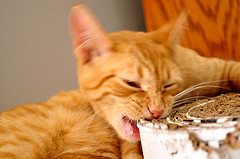
Photo via Flickr/Creative Commons by Jessica Fiess-Hill
The current study surveyed owners of cats with pica (N=91) alongside a control group of owners whose cats were not reported to have ingestion disorders (N=35). Owners were asked many questions about the cat (such as age, sex, breed), as well as questions about the household (people in the home, other pets, what types of enrichment such as toys and perches were available), and whether the cats had access to the outdoors. The researchers also asked questions about the presence of other behavioral issues as well as gastrointestinal disorders (from farting to vomiting). Perhaps importantly, they also asked owners if the cats ingested or just chewed on non-food items, and if so, what kinds of objects they liked to chew or eat.
Results suggested that in cats with pica, there were two types: specialists and generalists. Specialists preferred one type of item to ingest, while generalists had several things they liked to eat besides food. The most common targets were shoelaces/thread, plastic, fabric, rubber, or paper/cardboard. Some cats also enjoyed snacking on ear plugs, tape, toilet paper, sponges, and fabric softener sheets.
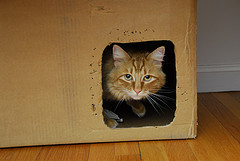
Surprisingly, the study demonstrated that many cats are “chewers” – of all the cats in the study, 70% of the pica cats and 60% of the control group chewed on non-food items, even if they didn’t ingest these items. Seventy-three percent preferred plastic, with 61% enjoying chewing on paper, and 45% chewing on rubber.
Although both pica and control cats like to chew, there were some differences between the two groups. Control cats were more likely to have food available at all times; pica cats were more likely to show more self-grooming behavior; pica cats were more likely to have access to the outdoors; and pica cats were reported to vomit more frequently than control cats.
These findings suggest many questions for further study. First of all, why so much chewing? One possibility is that, as hunters, cats would be spending a lot of time chewing and crunching through the flesh and bones of mice, birds, and other small creatures. Research has suggested that the act of chewing may activate areas of the cat’s brain that are serotonergic (meaning releasing and responding to serotonin), hinting that chewing might have some “feel good” properties for cats.
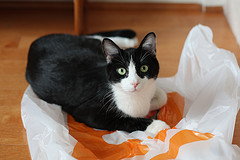
Why is plastic so popular? No one really knows. Some have suggested that some of the ingredients used for making plastic may be appealing, or that perhaps the sound of the bag crunching is somehow satisfying. I recommend playing it safe, and keeping plastic bags out of reach of your cat.
Is hunger a cause of pica? Cats exhibiting pica were more likely to be fed on a schedule. While scheduled feeding can have its benefits, such as weight control, cats are used to eating several small meals throughout the day. Future research needs to look at the pros and cons of scheduled feeding for cats, and how feeding regimen might interact with other household variables (such as use of food puzzles, exercise and enrichment options, and social factors, such as how the food is dispensed to the cat).
Many of the pica cats were vomiting frequently. It is possible that pica is related to digestive disorders or discomfort – and that the chewing is an attempt to relieve discomfort. Since this was a survey-based study, we don’t know if any of these cats were under treatment for vomiting (especially given that many people think vomiting is normal in cats – but frequent vomiting is a sign that your cat needs to see a vet). Another question for future exploration – the interplay between pica and gastrointestinal issues.
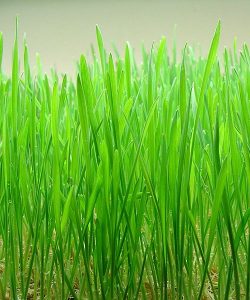
If your cat is a chewer, take note: accidental ingestion of non-food items by your cat can lead to expensive surgeries, or even death. While it might seem odd or cute, this behavior merits close attention to ensure that your cat is not injuring himself while chewing. Be sure to mention this behavior to your veterinarian, and try offering your cat plenty of appropriate and safe chewing options: cat grass, dental kibble from a food puzzle, and chew toys are all good places to start!

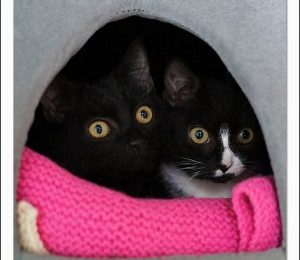
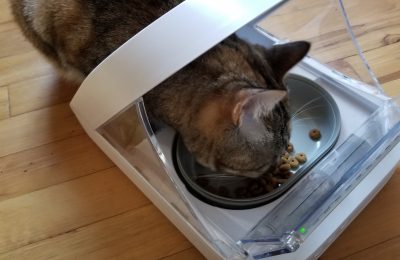
Thanks for another great article, Mikel! I was just talking with someone who informed me that her cat likes chewing on plastic pens and such, but doesn’t ingest them. I will suggest that she purchase an appropriate plastic chew toy and pass along this article to her! 🙂